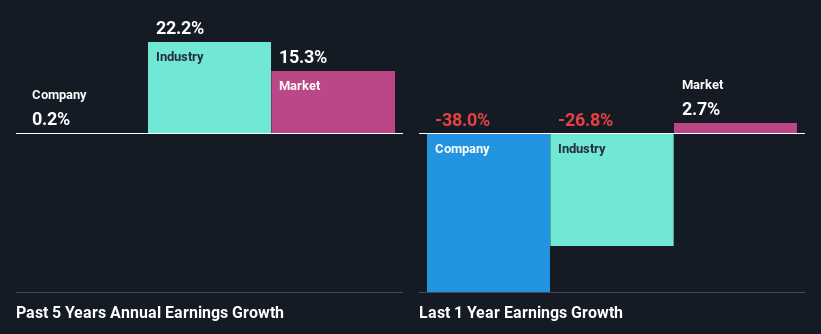Stock Analysis
- Sweden
- /
- Construction
- /
- OM:SKA B
Is Skanska AB (publ)'s (STO:SKA B) Recent Price Movement Underpinned By Its Weak Fundamentals?

It is hard to get excited after looking at Skanska's (STO:SKA B) recent performance, when its stock has declined 5.0% over the past month. It is possible that the markets have ignored the company's differing financials and decided to lean-in to the negative sentiment. Fundamentals usually dictate market outcomes so it makes sense to study the company's financials. Specifically, we decided to study Skanska's ROE in this article.
ROE or return on equity is a useful tool to assess how effectively a company can generate returns on the investment it received from its shareholders. In simpler terms, it measures the profitability of a company in relation to shareholder's equity.
Check out our latest analysis for Skanska
How Is ROE Calculated?
The formula for return on equity is:
Return on Equity = Net Profit (from continuing operations) ÷ Shareholders' Equity
So, based on the above formula, the ROE for Skanska is:
8.7% = kr4.9b ÷ kr57b (Based on the trailing twelve months to March 2024).
The 'return' is the yearly profit. Another way to think of that is that for every SEK1 worth of equity, the company was able to earn SEK0.09 in profit.
Why Is ROE Important For Earnings Growth?
So far, we've learned that ROE is a measure of a company's profitability. Depending on how much of these profits the company reinvests or "retains", and how effectively it does so, we are then able to assess a company’s earnings growth potential. Assuming everything else remains unchanged, the higher the ROE and profit retention, the higher the growth rate of a company compared to companies that don't necessarily bear these characteristics.
Skanska's Earnings Growth And 8.7% ROE
When you first look at it, Skanska's ROE doesn't look that attractive. Yet, a closer study shows that the company's ROE is similar to the industry average of 8.7%. However, Skanska has seen a flattish net income growth over the past five years, which is not saying much. Remember, the company's ROE is not particularly great to begin with. So that could also be one of the reasons behind the company's flat growth in earnings.
Next, on comparing with the industry net income growth, we found that Skanska's reported growth was lower than the industry growth of 22% over the last few years, which is not something we like to see.

The basis for attaching value to a company is, to a great extent, tied to its earnings growth. It’s important for an investor to know whether the market has priced in the company's expected earnings growth (or decline). This then helps them determine if the stock is placed for a bright or bleak future. Is SKA B fairly valued? This infographic on the company's intrinsic value has everything you need to know.
Is Skanska Efficiently Re-investing Its Profits?
In spite of a normal three-year median payout ratio of 40% (or a retention ratio of 60%), Skanska hasn't seen much growth in its earnings. So there might be other factors at play here which could potentially be hampering growth. For example, the business has faced some headwinds.
Additionally, Skanska has paid dividends over a period of at least ten years, which means that the company's management is determined to pay dividends even if it means little to no earnings growth. Upon studying the latest analysts' consensus data, we found that the company's future payout ratio is expected to rise to 50% over the next three years. Still, forecasts suggest that Skanska's future ROE will rise to 11% even though the the company's payout ratio is expected to rise. We presume that there could some other characteristics of the business that could be driving the anticipated growth in the company's ROE.
Summary
On the whole, we feel that the performance shown by Skanska can be open to many interpretations. Even though it appears to be retaining most of its profits, given the low ROE, investors may not be benefitting from all that reinvestment after all. The low earnings growth suggests our theory correct. With that said, the latest industry analyst forecasts reveal that the company's earnings are expected to accelerate. To know more about the company's future earnings growth forecasts take a look at this free report on analyst forecasts for the company to find out more.
Valuation is complex, but we're helping make it simple.
Find out whether Skanska is potentially over or undervalued by checking out our comprehensive analysis, which includes fair value estimates, risks and warnings, dividends, insider transactions and financial health.
View the Free AnalysisHave feedback on this article? Concerned about the content? Get in touch with us directly. Alternatively, email editorial-team (at) simplywallst.com.
This article by Simply Wall St is general in nature. We provide commentary based on historical data and analyst forecasts only using an unbiased methodology and our articles are not intended to be financial advice. It does not constitute a recommendation to buy or sell any stock, and does not take account of your objectives, or your financial situation. We aim to bring you long-term focused analysis driven by fundamental data. Note that our analysis may not factor in the latest price-sensitive company announcements or qualitative material. Simply Wall St has no position in any stocks mentioned.
About OM:SKA B
Skanska
Operates as a construction and project development company in the Nordic region, Europe, and the United States.
Excellent balance sheet and good value.

